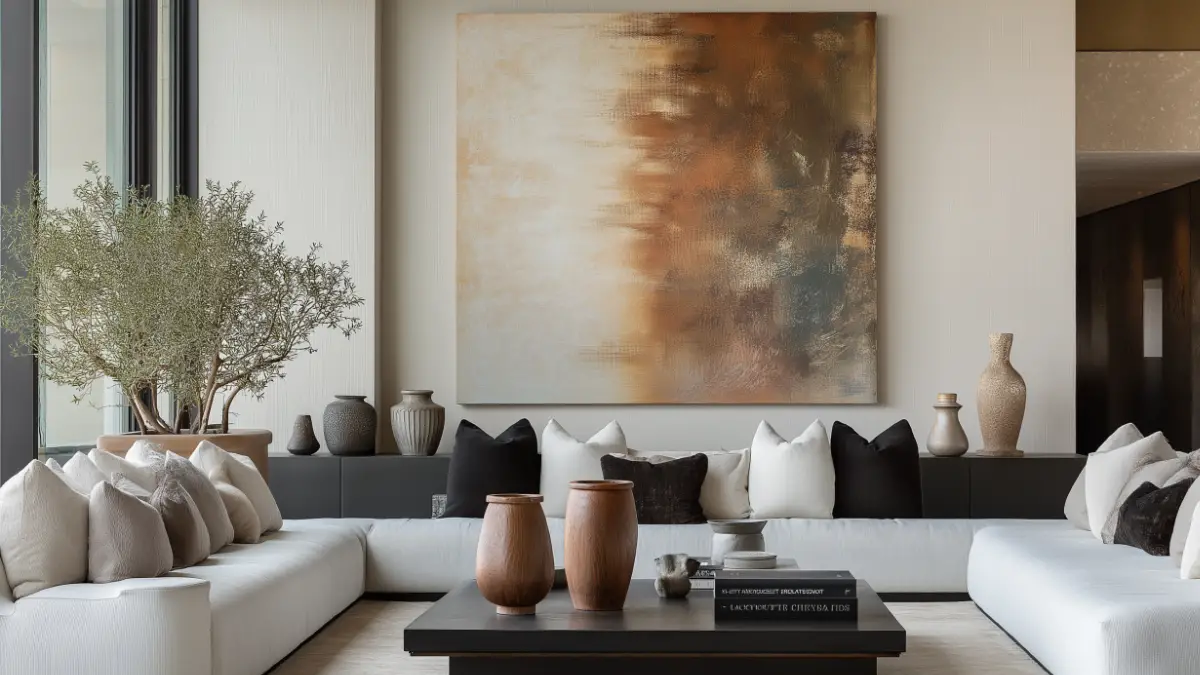How to Achieve a Modern Contemporary Living Room Look with Style and Ease
Table of Contents
What does “modern contemporary” really mean in interior design? While often used interchangeably, this design style is a refined fusion of clean lines, neutral palettes, and functional minimalism—grounded in warmth and sophistication. According to recent design trend reports, modern contemporary interiors have surged in popularity as homeowners seek spaces that are both sleek and livable.
A modern contemporary living room combines current design sensibilities with timeless elements, favoring open layouts, statement pieces, and thoughtfully curated decor. It’s not about stark minimalism—it’s about balance, intention, and subtle luxury.
This post will guide you through every key element you need to achieve a modern contemporary living room, from selecting the perfect color scheme to choosing the right textures, lighting, and furniture. Whether you’re refreshing your current setup or planning a full redesign, these ideas will help you create a space that feels fresh, inviting, and effortlessly stylish.
In-Depth Outline
1. Define the Modern Contemporary Aesthetic
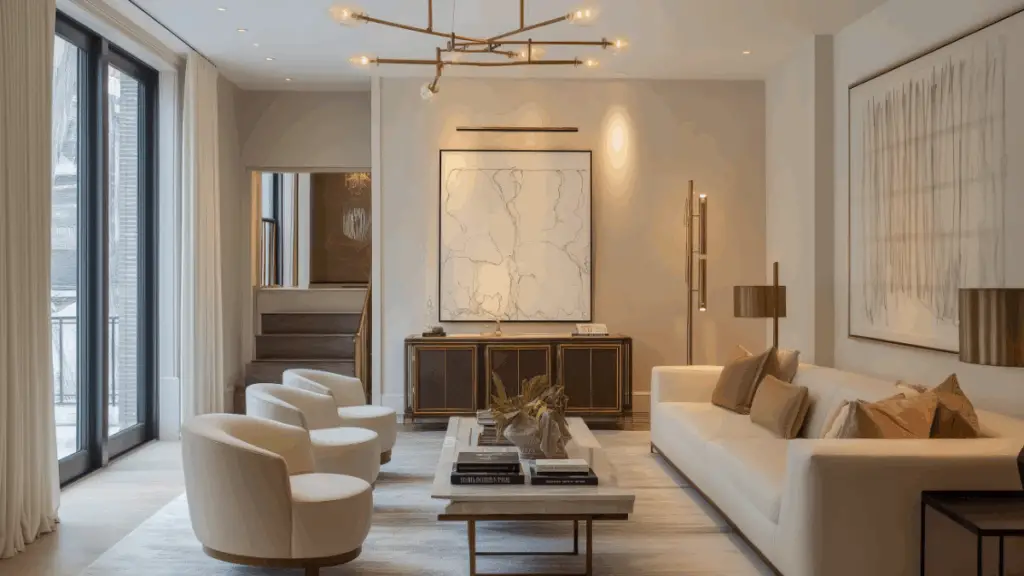
Key Characteristics
- Clean lines with balanced symmetry.
- Neutral palettes with pops of color.
- Emphasis on function and form.
Style Fusion
- Modern: rooted in simplicity, open space, and neutral colors.
- Contemporary: adaptable, current, and design-forward.
What to Avoid
- Over-accessorizing or clutter.
- Heavy traditional furniture.
- Busy patterns and ornate detailing.
2. Choose a Refined Color Palette
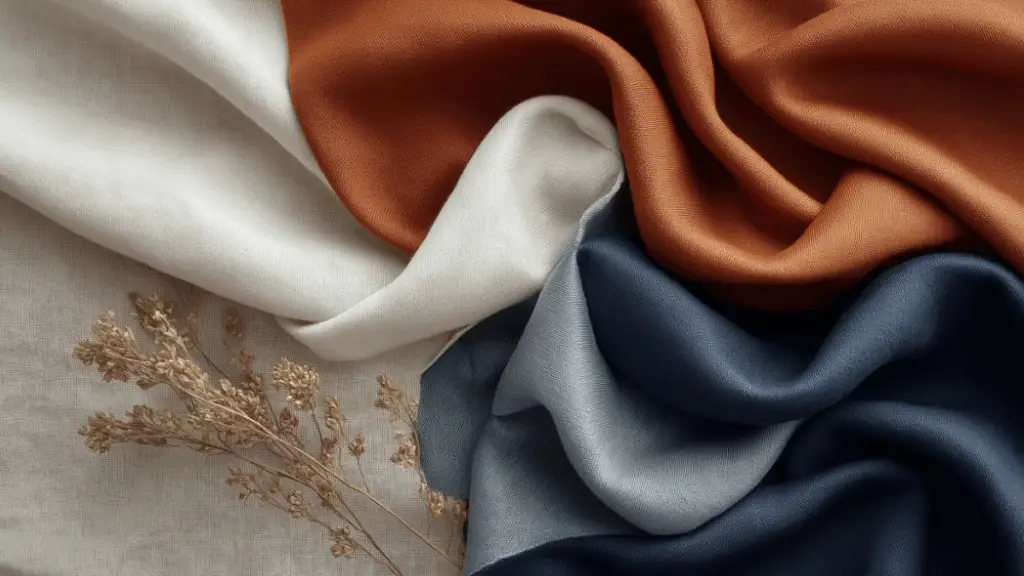
Neutral Foundations
- White, beige, greige, charcoal, and taupe as the base.
- Create visual calm with tone-on-tone layering.
Add Accents Strategically
- Incorporate one or two bolder shades—navy, forest green, rust.
- Use artwork, pillows, or a statement chair for contrast.
Palette Planning Table
| Base Tone | Accent Color | Style Mood |
|---|---|---|
| Warm White | Rust Orange | Earthy and Modern |
| Greige | Black + Brass | Sleek and Sophisticated |
| Charcoal Gray | Navy Blue | Urban and Refined |
3. Select Modern Yet Inviting Furniture
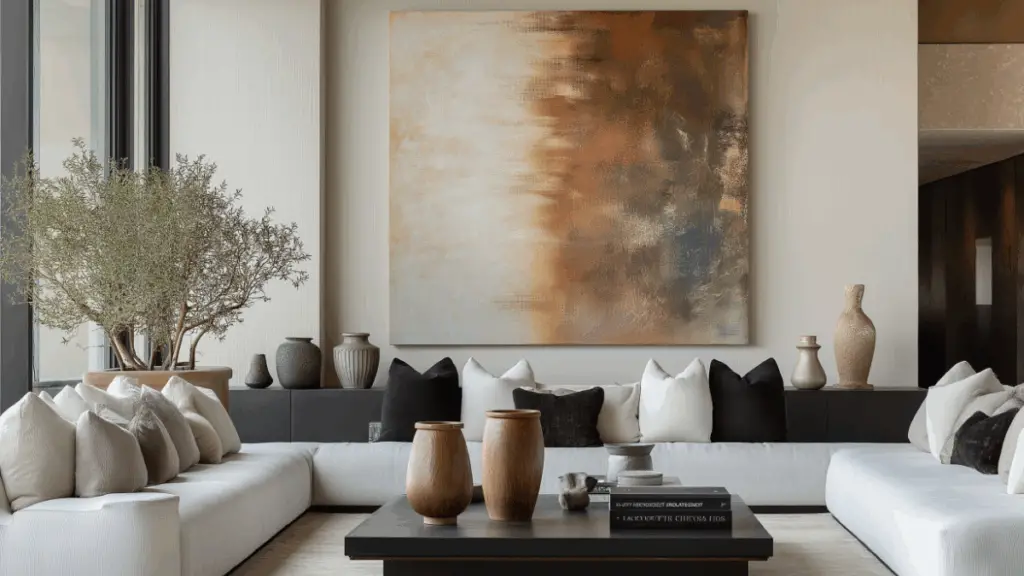
Focus on Form and Function
- Look for clean silhouettes with minimal detailing.
- Modular or low-profile sofas in neutral tones are ideal.
Materials Matter
- Combine soft fabrics (linen, boucle) with sleek finishes (metal, glass).
- Avoid overly ornate or heavy furniture.
Best Furniture Types Table
| Furniture Type | Recommended Finish | Design Benefit |
|---|---|---|
| Sofa | Neutral linen or leather | Streamlined yet cozy |
| Coffee Table | Glass or oak wood | Lightens space and adds contrast |
| Side Chairs | Velvet or boucle | Adds soft luxury and shape |
4. Create an Open, Balanced Layout
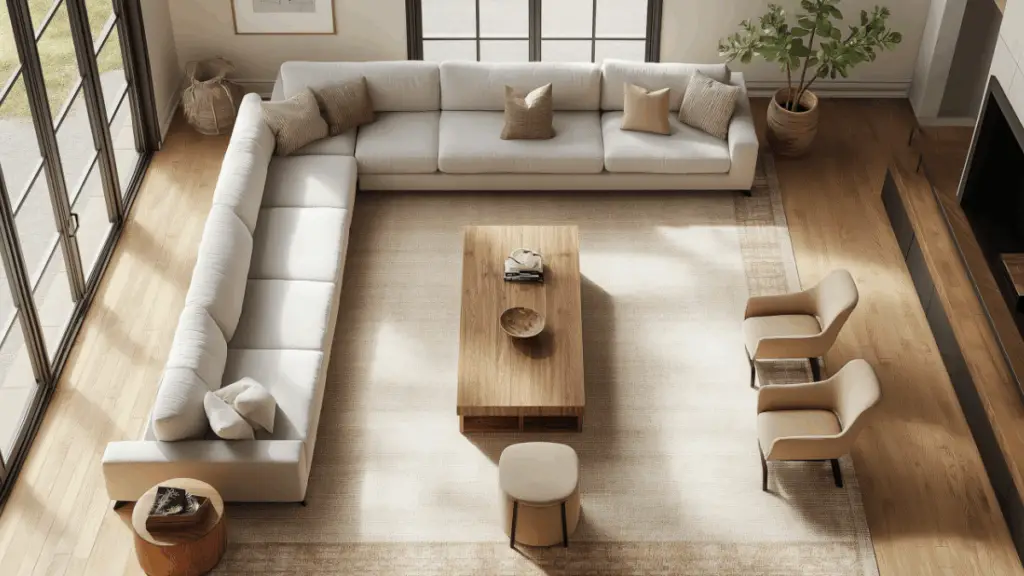
Emphasize Negative Space
- Don’t overfill the room—leave breathing room between pieces.
- Float furniture off walls to define zones.
Functional Groupings
- Anchor with a large rug and build around central seating.
- Balance scale with proportional accessories.
Layout Tips Table
| Element | Modern Approach | Why It Works |
|---|---|---|
| Rug Placement | Under front sofa legs | Grounds the seating area |
| Furniture Layout | Symmetrical with space | Promotes flow and visual order |
| Shelving | Minimal, curated pieces | Prevents clutter, adds focus |
5. Layer Lighting for Mood and Function
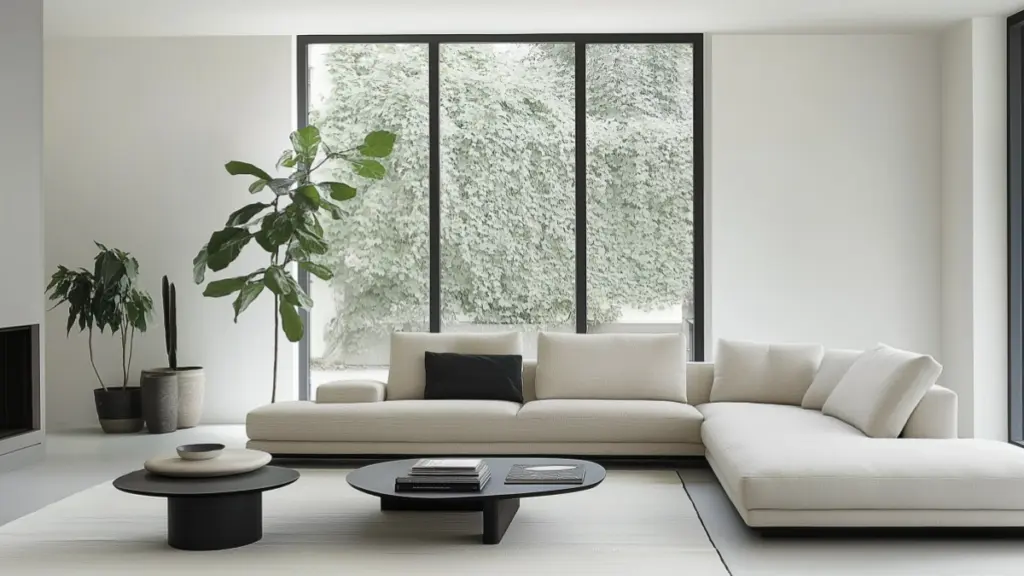
Use a Mix of Light Sources
- Ambient (ceiling lights), task (floor/reading lamps), accent (spotlighting art).
- Layer light to soften hard lines and create ambiance.
Modern Fixture Types
- Sleek black, brass, or glass fixtures.
- Consider sculptural or asymmetrical designs.
Lighting Strategy Table
| Lighting Type | Example Fixture | Best Placement |
|---|---|---|
| Ambient | Flush mount or track | Ceiling center or perimeter |
| Task | Arc floor lamp | Beside sofa or reading corner |
| Accent | Wall sconce or uplight | Art walls or bookshelf area |
6. Decor and Accessories: Less Is More
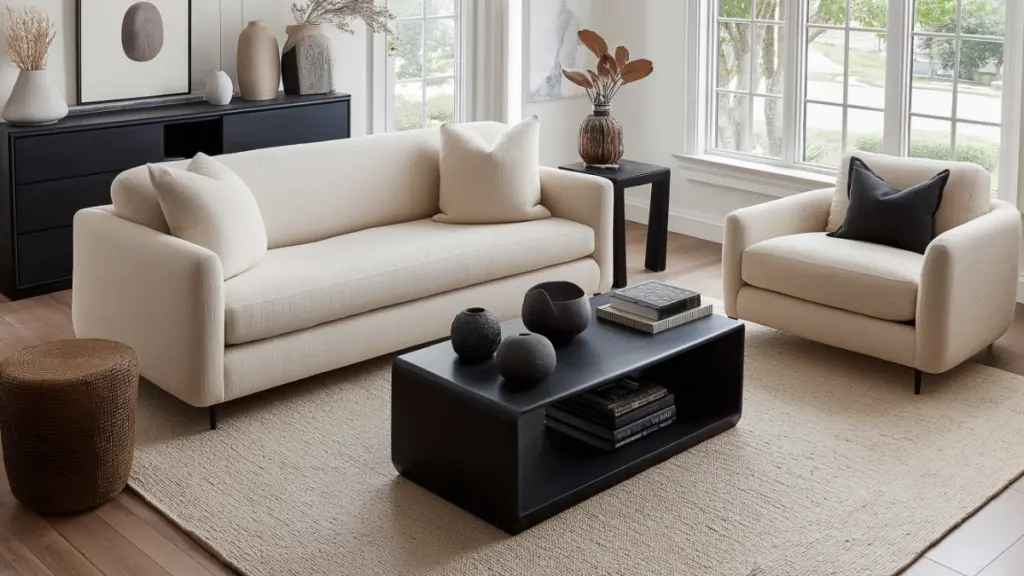
Use Texture for Interest
- Layer boucle, wool, ceramic, and matte metals.
- Stick to 3–5 textures in a restrained palette.
Art and Decor Rules
- Opt for large abstract prints or sculptural art.
- Keep decor minimal but intentional—avoid excessive items.
Styling Dos and Don’ts Table
| Do | Don’t |
|---|---|
| Large-scale art | Gallery walls with small frames |
| Sculptural decor | Over-decorated shelves |
| Natural textures | Shiny plastic or faux finishes |
Detailed Content Expansion:
3. Select Modern Yet Inviting Furniture
When selecting furniture for a modern contemporary living room, prioritize clean lines, comfort, and understated elegance. The foundation of this style lies in simplicity—but simplicity that feels warm, not stark.
Start with a neutral sofa in linen, tweed, or leather. Choose a piece with low arms and a structured profile. If space allows, add a matching or contrasting accent chair in boucle, velvet, or a soft woven fabric. These chairs can introduce visual softness and shape, especially in a room dominated by linear forms.
Avoid overly ornamental furniture. Instead, choose simple silhouettes with rich materials. A black metal coffee table with a glass top, for example, adds dimension without bulk. Natural oak or walnut adds warmth and breaks up monochrome tones.
Balance is also achieved through scale. Use slim-legged tables to maintain visual flow and introduce open-bottomed furniture that feels airy. A large area rug in a solid or subtle pattern grounds the space without overwhelming it.
Lastly, opt for furniture that is both functional and flexible. Modular seating or nesting tables can adapt to changing needs—an essential quality in any contemporary space.
5. Layer Lighting for Mood and Function
Lighting is essential in modern contemporary living rooms—not just for visibility, but for atmosphere. A layered approach ensures your space remains warm, dynamic, and adaptable throughout the day.
Start with ambient lighting. Recessed lights or flush-mount ceiling fixtures provide general illumination without interrupting clean ceiling lines. Choose fixtures with matte finishes in black, white, or brushed brass for a modern touch.
Next, add task lighting for reading or working zones. Floor lamps with sleek arcs or minimalist profiles are perfect next to sofas or reading chairs. If you prefer something less visible, slim table lamps on side tables can provide targeted light while blending into the decor.
Finally, introduce accent lighting to elevate the mood. Wall sconces, picture lights, or LED strips behind shelving units add drama and depth. Lighting artwork or architectural features also enhances the contemporary elegance of the space.
Always use warm white bulbs (2700K–3000K) to soften the sharper angles common in modern design. This warmth keeps the space inviting and layered rather than clinical.
Conclusion
Achieving a modern contemporary living room is all about thoughtful restraint. By choosing a refined color palette, functional furniture, strategic lighting, and minimal yet impactful decor, you can create a space that feels as polished as it is welcoming. The key lies in balance—pairing clean lines with rich textures, open layouts with curated accessories, and neutral tones with bold accents. With these ideas, your living room can embody timeless style and modern comfort effortlessly.

